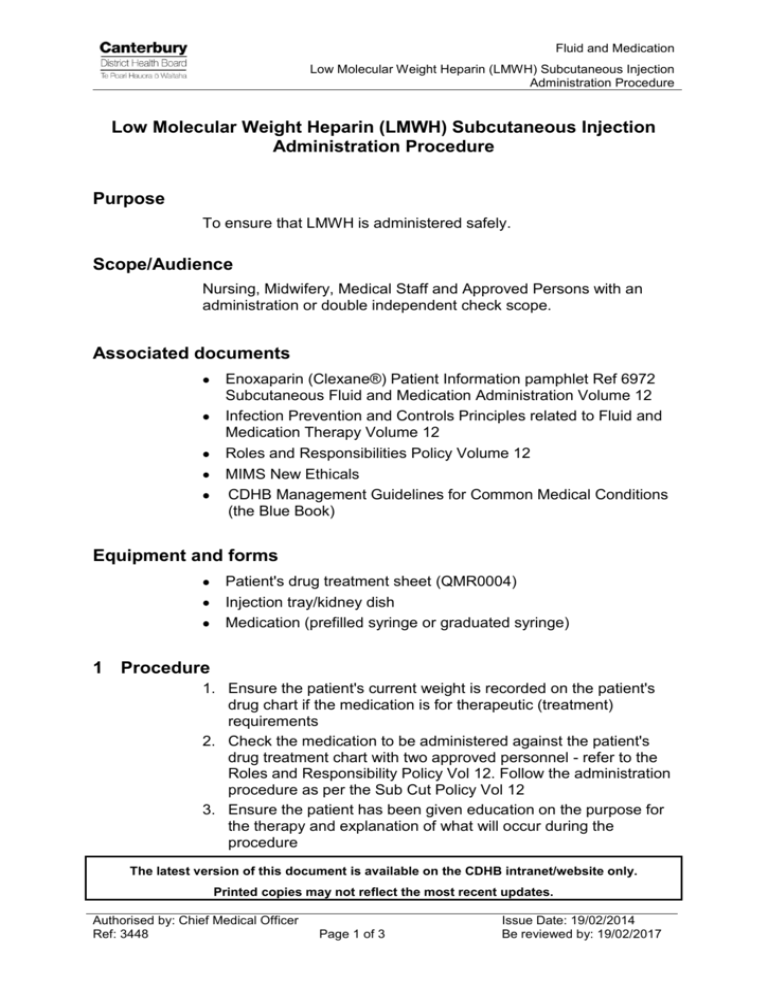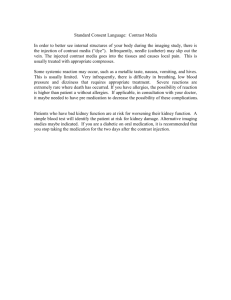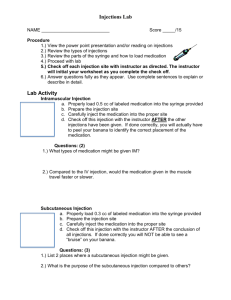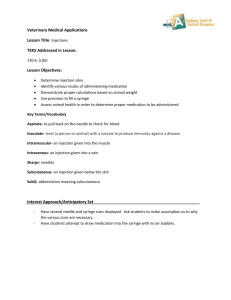Low Molecular Weight Heparin (LMWH) Subcutaneous Injection
advertisement

Fluid and Medication Low Molecular Weight Heparin (LMWH) Subcutaneous Injection Administration Procedure Low Molecular Weight Heparin (LMWH) Subcutaneous Injection Administration Procedure Purpose To ensure that LMWH is administered safely. Scope/Audience Nursing, Midwifery, Medical Staff and Approved Persons with an administration or double independent check scope. Associated documents Enoxaparin (Clexane®) Patient Information pamphlet Ref 6972 Subcutaneous Fluid and Medication Administration Volume 12 Infection Prevention and Controls Principles related to Fluid and Medication Therapy Volume 12 Roles and Responsibilities Policy Volume 12 MIMS New Ethicals CDHB Management Guidelines for Common Medical Conditions (the Blue Book) Equipment and forms Patient's drug treatment sheet (QMR0004) Injection tray/kidney dish Medication (prefilled syringe or graduated syringe) 1 Procedure 1. Ensure the patient's current weight is recorded on the patient's drug chart if the medication is for therapeutic (treatment) requirements 2. Check the medication to be administered against the patient's drug treatment chart with two approved personnel - refer to the Roles and Responsibility Policy Vol 12. Follow the administration procedure as per the Sub Cut Policy Vol 12 3. Ensure the patient has been given education on the purpose for the therapy and explanation of what will occur during the procedure The latest version of this document is available on the CDHB intranet/website only. Printed copies may not reflect the most recent updates. Authorised by: Chief Medical Officer Ref: 3448 Page 1 of 3 Issue Date: 19/02/2014 Be reviewed by: 19/02/2017 Fluid and Medication Low Molecular Weight Heparin (LMWH) Subcutaneous Injection Administration Procedure 4. Ensure patient is lying comfortably 5. Select appropriate injection site 6. Ensure if administering into abdomen that you avoid the umbilicus by 5cm diameter 7. Prefilled disposable syringes are ready for immediate use 8. If lesser dose is required, calculate the amount required, and depress the plunger of the syringe to discard medication not required. Do not expel air bubble. Please Note: For 60mg doses or greater invert the syringe allowing for the air bubble to float to plunger end before discarding the medication not required. 9. Do not expel the air bubble from syringe before the injection. 10. Tap the syringe so that the air bubble rises to plunger end. Please Note: Administration should be alternated between left and right anterior abdominal wall avoiding the umbilicus by at least 5cm. 11. Remove the needle sheath and hold syringe between thumb and forefinger of dominant hand. 12. Gently grasp the skin between your thumb and forefinger to lift the skin away from the underlying muscle 13. Insert whole length of needle vertically (at a 90 degree angle) into skin fold. Be sure to hold the skin fold throughout the injection. 14. Inject the solution slowly over at 30 seconds and wait 10 seconds before withdrawing the needle (significantly reduces bruising) 15. Remove the needle by pulling it straight out then release the skin fold 16. Do not rub injection site after administration 17. Do not recap needle. Discard into point of use sharps container. 18. Both approved personnel to record the administration of the medication on the prescription chart as per Roles and Responsibilities Policy Vol 12 19. Report any abnormalities or complications immediately. The latest version of this document is available on the CDHB intranet/website only. Printed copies may not reflect the most recent updates. Authorised by: CDHB Fluid and Medication Committee Ref: 3448 Page 2 of 3 Issue Date: 19/02/2014 Be reviewed by: 19/02/2017 Fluid and Medication Low Molecular Weight Heparin (LMWH) Subcutaneous Injection Administration Procedure References Ministry of Justice Coronial Services Unit , March 2010 Coroners Report Crisp, J., & Taylor, C. (2008). Professional standards in nursing practice. In Potter and Perry’s Fundamentals of Nursing.(3rd ed.). Chatswood,Nsw: Elsevier. Hunter, J (2008). Subcutaneous injection technique.Nursing Standard. 22,(21) 41-44. Medsafe data sheet on Clexane (Enoxaparin) April 2010 http://medsafe.govt.nz/profs/Datasheet/c/Clexaneinj.pdf CDHB Patient Information Leaflet Enoxaparin April 2009 Sanofi Aventis (2010). Clexane injection ten steps CHAN, H. (2001) Effects of injection duration on site-pain intensity and bruising associated with subcutaneous heparin. Journal of Advanced Nursing 35(6), 882 – 892. Winslow, E.H., Jacobson, A.F. & Peragallo-Dittko, V.M.A. (1997) Rethinking subcutaneous injection technique. American Journal of Nursing 97(5), 71-72. CDHB Chief Medical Officers February 2014 review of the subcutaneous injection recommendations from a 2010 Coroners Report Procedure Owner Procedure Authoriser CDHB Fluid and Medication Management Committee Chief Medical Officer Date of Authorisation 19 February 2014 The latest version of this document is available on the CDHB intranet/website only. Printed copies may not reflect the most recent updates. Authorised by: Chief Medical Officer Ref: 3448 Page 3 of 3 Issue Date: 19/02/2014 Be reviewed by: 19/02/2017






